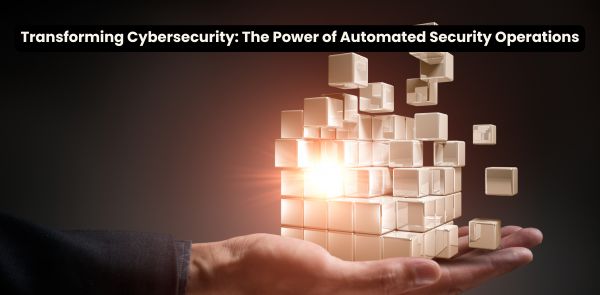
Cyber threats are on the rise than ever. No Manual security operations are any more helpful to keep up with attacks’ speed, complexity, and volume. When an organization introduces the automation of security operations – a transformative approach leveraging advanced technologies to enhance detection, response, and mitigation capabilities.
Read more about how automation is revolutionary in terms of cybersecurity. Know why is it needed for any business to adopt it.
You should look forward to Automate in Security Operations.
Here are the three reasons why?
- Increase in Threat Volume: The attack style in cyber world is escalating very frequently. The way of attack has gotten more sophisticated. While the most experienced security teams may feel it tedious to analyze and monitor in manually.
- Skill Gap in Cybersecurity: You must partner with qualified professionals. A shortage of skilled cybersecurity professionals leaves organizations struggling to adequately staff their security operations centers (SOCs).
- Complex Security Architectures: Modern organizations operate in hybrid environments, making manual management of disparate security tools inefficient and error-prone.
Complex Security Architecture: Today the majority of organizations are allowing hybrid work patterns. Manual management security protection can fail to perform as the disparate security tools
Manual Systems: Slow to process large volumes of data and alerts, often leading to delays in threat detection and response.
Automated Systems: Can handle massive data streams and respond in real-time, mitigating threats before they escalate.
5 Key Benefits of Automating Security Operations
- Threat detection and responses: Automation tools use technologies like Machine learning (ML) and Artificial Intelligence (AI) to identify anomalous behavior and automatically detect, investigate, and respond to cyber threats
- Reduced Human Error: Automated processes eliminate inconsistencies caused by fatigue or oversight, ensuring consistent and accurate handling of security incidents.
- Efficient Resource Utilization: By automating repetitive tasks such as log analysis, threat intelligence correlation, and alert prioritization, security teams can focus on strategic decision-making and complex investigations.
- Improved Scalability: Automation enables organizations to manage security across expansive and dynamic IT environments without proportional increases in manpower.
- Cost Savings: Reducing manual intervention in routine tasks lowers operational costs and minimizes potential financial damage from breaches.
5 Core Components of Automated Security Operations
- Security Orchestration, Automation, and Response (SOAR): SOAR platforms integrate with multiple security tools to automate workflows, enabling faster and more coordinated responses to incidents.
- Endpoint Detection and Response (EDR): EDR solutions monitor endpoints for suspicious activities and automatically contain threats before they spread.
- Threat Intelligence Platforms: Automated platforms aggregate, analyze, and act on real-time threat intelligence, enhancing proactive defenses.
- Behavioral Analytics: Machine learning-driven analytics detect deviations from normal user or network behavior, flagging potential threats.
- Automated Incident Response Playbooks: Predefined response plans executed automatically to handle common security scenarios, reducing the need for manual intervention.
Challenges in Implementing Security Automation
- Integration Complexity: Ensuring seamless integration between legacy systems and modern automation tools can be challenging.
- Initial Investment: Deploying automation solutions requires significant upfront investment in tools, training, and infrastructure.
- Over-reliance on Automation: While automation is a powerful ally, human oversight remains critical for interpreting nuanced threats and making strategic decisions.
- Customization Requirements: Organizations may need to tailor automation workflows to align with their unique security policies and risk tolerance.
The Future of Security Operations
As cyber threats grow in complexity, the automation of security operations will become indispensable. Emerging technologies such as AI-driven predictive analytics, autonomous threat hunting, and self-healing systems promise to elevate automation capabilities even further. Organizations that embrace automation today position themselves to defend against tomorrow’s threats effectively.
The automation of security operations is not just a trend—it’s a necessity for organizations aiming to stay ahead of cyber adversaries. By leveraging automation, businesses can achieve faster threat detection, streamlined responses, and more resilient security infrastructures. For those yet to adopt, the time to act is now—the future of cybersecurity depends on it.
Connect with us to learn how your organization can implement and benefit from cutting-edge security automation solutions.
